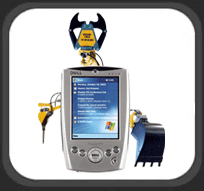| Choosing a Personal Digital Assistant - Page 2 of 2 |
Size:
The overall size may vary from model to model, but in general the length and width of a PDA will be in the range of a 3” x 5” index card. These values may vary slightly, and a difference of a few fractions of an inch may be important to a user with specific space constraints. For example, comparing the measurements of a Toshiba 830w (5.31” by 3.03” by 0.65”), to those of a Compaq Ipaq 3950 (4.54” x 3.00” x 0.61”), shows that the width and thickness are nearly identical. But, the difference of more than ¾” in height may be a big deal when trying to fit into a briefcase pocket, or even a shirt pocket.
The weight may be directly related to size, and is perhaps another relevant area worth considering. The weight of a typical PDA may be just a few ounces (several hundred grams), so you obviously aren’t going to strain yourself toting it. The difference between one model and another may be due to the variety and quantity of extra features included, and in general, an individual’s requirements for functionality may influence the overall weight.
Another key aspect when referencing size as it applies to PDAs is the screen size. Large screens, with higher resolutions, will allow the user to operate more comfortably. Using the same two PDAs referenced in this section, we see that the Toshiba 830w sports a 4.0” (480x640 resolution) screen while the Compaq Ipaq 3950 has a 3.8” (240x320 resolution) screen. So, the overall size of the Toshiba is a bit larger but it makes good use of the space by including a larger display capable of twice the resolution of the Compaq.
Battery Life:
Most PDAs are now provided with an integrated rechargeable battery which recharges while connected to a base station or power adaptor. The most common type of rechargeable battery may be Lithium Ion (Li-Ion), and a general gauge of a battery’s capacity is provided in terms of mAh (milliAmp hours). Although real-world performance will vary among devices and how they are used, a battery with a higher mAh value will be able to hold a greater charge and last longer between charges.
The general use of the device will obviously play a role in how long the batteries will last, and is a difficult number to provide with any certainty. Manufacturers may provide a figure on the normal life between charges, but this is most likely based on occasional use, where it is idling for a majority of the time. This figure may indicate battery life of up to several days on one charge, but under more intensive operation, the battery life could be cut significantly. Watching a movie, listening to audio files, or playing games may drop the life on one charge from a few days down to a few hours. Use of wireless networking and display backlighting are two other things that can seriously impact battery life on any PDA, regardless of the type or quality of batteries included.
Your best bet for information on battery life is to seek out independent reviews or owner comments on a PDA of interest.
Expandability:
PDAs generally come with a base amount of memory on board for storing data and applications, but they can be filled up quite quickly. Most of these devices now include slots that will accept some sort of flash memory to increase their capacity (Click here for Tech Tips on Flash Memory: Part I and Part II). Typical formats supported by PDAs include: Compact Flash, SD, MMC, or Memory Stick.

Flash memory is fairly cheap these days, but selecting a PDA based on a format that one already uses could be a good idea. An SD card, for example, could be shared between a PC, digital camera, MP3 player, and a PDA to move various multimedia and application files between the devices.
A PDA such as the HP iPaq rz1715 offers an SD/MMC slot for expandability, while the Dell Axim X5 offers the convenience of multiple flash memory slots, providing support for Compact Flash, SD, and MMC.
In addition to choosing the proper format of flash memory for your PDA, it may also be necessary to consider the capacity of the card chosen. Although you may be able to purchase a 2GB flash memory card, for example, that does not mean every PDA will be able to access it. Check the PDA manufacturer’s specifications, especially on older models, to confirm that there is no maximum card size that it will accept.
In addition to allowing additional storage space, expansion slots can be used for other devices, as well. GPS receivers are popular accessories for PDAs, and can be found with different interfaces to match the slots available on a PDA. Leadtek is one manufacturer offering both Compact Flash and Secure Digital based GPS receivers. Another innovation, from companies such as SanDisk, are combination memory and WiFi cards. However, be sure to check compatibility with your current PDA as some PDAs have problems “using” the extra features.
Final Words:
With all of the options available, PDAs are far more versatile than they ever used to be. Finding a device with the flexibility to be useful for both business and pleasure doesn’t have to be a daunting task if a few key considerations are identified early in the process. A good balance of performance, size, and capabilities should be easily achieved, while still respecting a reasonable budget.
Page 1 | Page 2 | Home | Forum | Review Index
Get Tech Tips and Computer Tips at Geeks.com!
|
|
|
|